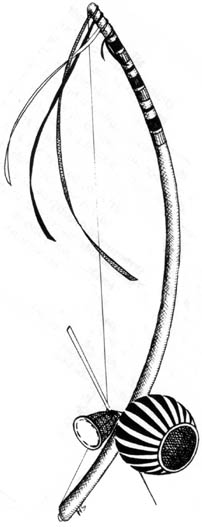 |
 The
Brazilian Berimbau by Tadeu
Batista
The
Brazilian Berimbau by Tadeu
Batista
"O berimbau e um instrumento feito de uma corda so. A cabaça e o caxixi camara, ahi esta o berimbau"
"The berimbau is an instrument made of one string alone. A cabaça and a caxixi my friend and there you have a berimbau.”
So begins a popular capoeira song describing the berimbau; without this there is no capoeira.
The berimbau is composed of a bow-like body, however rather than shooting
arrows the performer strikes the cord with a stick. This produces a deep
resonance - the trademark 'Wah-Wah' sound - that is controlled by the
movement of the cabaça against the musician's body. A coin or stone
pressed against the string provide further control and a small caxixi
shaker completes the instrument.
The African slaves brought the Berimbau to Brazil where it is now closely
associated with Capoeira.
Capoeira is an Afro-Brazilian martial art that intertwines music and dance in order to create a unique form of self-expression. Capoeira music is performed by the 'fighter / dancers' themselves who sing and play percussion instruments including: the pandeiro, agogo, atabaque or conga and at least one or two Berimbaus.
THE BODY
Traditionally berimbaus are made of 'Biriba" wood, but you can now
find berimbaus made of other types of wood. One popular material used
for beginners' berimbaus is bamboo. Berimbaus range in size from 1m -
1.2m.
THE STRING
Traditionally the string of the berimbau was made from vine or similar
natural material. From the 1930's onwards the 'string' used was made from
the metal wire salvaged from an old tire. This process involves burning
away the rubber and then the cleaning the wire. Using this method a single
tire could net as much as 10 - 15m of wire. Nowadays the wire used is
mostly bought over the counter at hardware stores. The use of this wire
has allowed mass production of berimbaus and the sound quality remains
very acceptable. Other musicians prefer the sound produced by piano strings.
THE STICK (VAQUETA)
In order to produce sound a wooden stick known as the ‘vaqueta’
strikes the string of the berimbau. This stick is traditionally made using
an off-cut of the wood used to make the body of the berimbau. An approximately
40cm length of wood is cut into quarters and each piece is then polished
and varnished.
THE CAXIXI
The caxixi is a small shaker woven like a basket a filled with sea shells
or seeds. The basket structure can be woven from vine, bamboo or wicker.
I recommend using a caxixi woven from vine (cipo). Painting your caxixi
with glue will strengthen it and make it last that much longer. The use
of a caxixi is a technique that originated once the berimbau was brought
to Brazil. It is held in the same hand as the stick and adds emphasis
to the sound produced.
THE COIN/STONE
Traditionally the coins used were the old copper 'dobrão'. This
large coin was popular because its size made it easy to hold. Smooth flat
'skimming' stones from the beach are easier to obtain and produce an excellent
sound. What is not recommended are the cheap 'washers' that are normally
provided with shop bought berimbaus. Better to throw this out and replace
with a stone.
THE CABAÇA
The 'cabaça is made from a calabash. Once you have bought your
cabaça you can further enhance the sound by scraping the insides
with a metal spoon. Take care when doing this as the thinner the walls
the more fragile the cabaça. Keep checking the quality of sound
produced by the thinning of the calabash walls. Once you are happy with
the sound then fill the cabaça with hot sand. This burns off the
loose fibres, smoothening the inside and hardening the shell.
The size of the cabaça must be in proportion to the size of the berimbau. If the cabaça is too small the sound produced will be weak and without resonance. If the cabaça is too big, the sound looses its focus and the trademark 'wah-wah' sound is impossible to achieve.
THE DECORATION
Many of the berimbaus around today are highly colourful and brightly painted.
This is a recent trend started in the 1940's. Up until then berimbaus
were left their natural wood colour with a simple varnish for protection
Wondering how to put this into practice? A free demo illustrating the correct handling technique and sounds produced can de downloaded from www.bridgesto.com
 Tadeu
Batista is a Professional Brazilian Percussionist playing
in various bands worldwide for over 20 years. Tadeu is now concentrating
on sharing the knowledge he has built up over the years through articles,
workshops and educational videos.
Tadeu
Batista is a Professional Brazilian Percussionist playing
in various bands worldwide for over 20 years. Tadeu is now concentrating
on sharing the knowledge he has built up over the years through articles,
workshops and educational videos.